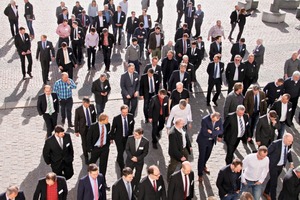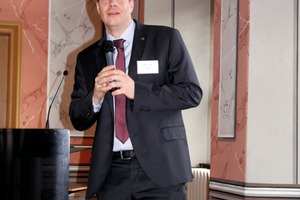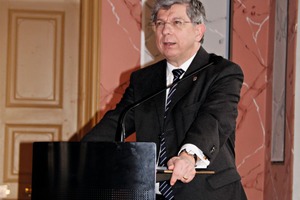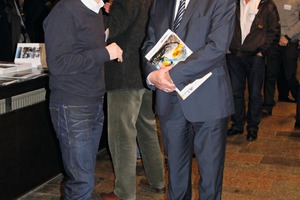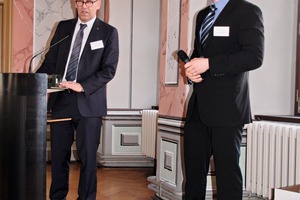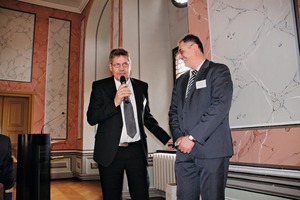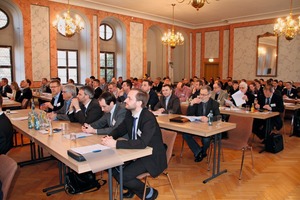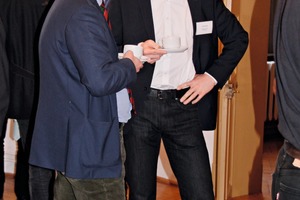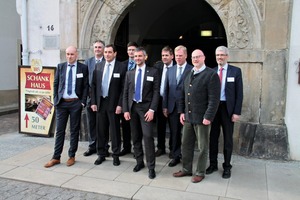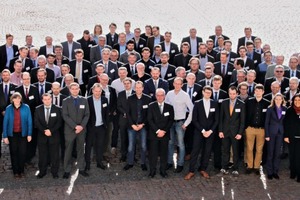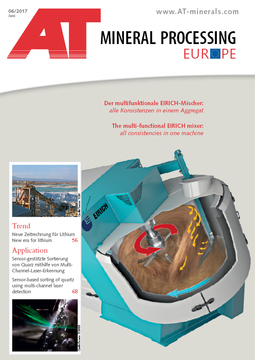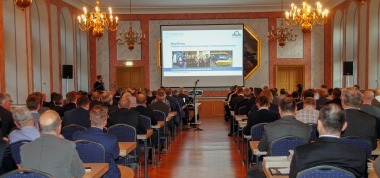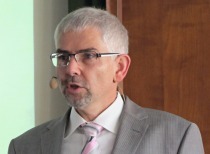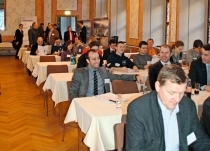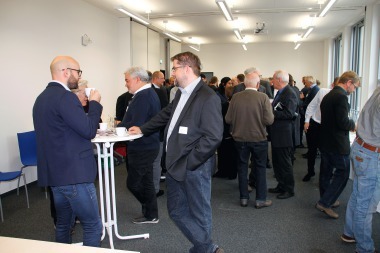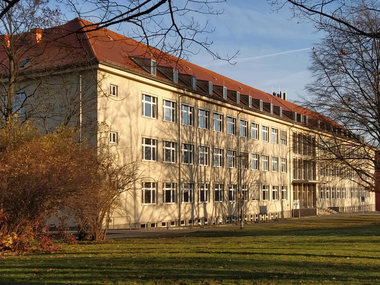Mineral Processing Symposium 2017
In early March 2017, more than 150 participants took up the invitation issued by the Institute of Mineral Processing Machines (IAM) at TU Bergakademie Freiberg. They took the opportunity to find out about the latest process and plant engineering developments and research findings presented in a total of ten papers as well as current reports from the field on the topic “Comminution and Classifying – Manufacturing, Characterizing, Drying, Separating and Recycling Products”.
At the beginning of the Conference, in his function as Chairman of the Friends and Supporters of the Institute of Mineral Processing Machines, Florian Festge, Haver & Boecker OHG, publicized the association’s work and the common goals. These include supporting research, development and teaching at the Institute by arranging field trips and awarding research topics for dissertations and theses. On the one hand, the manufacturing companies can profit from the research findings, on the other hand, this makes it easier for graduates – as future employees – to get into the industry at the start of their career. Florian Festge ended his report with an appeal to the conference participants to join and widen the existing circle of Friends and Supporters and award student papers and theses.
Prof. Dr. Holger Lieberwirth, Director of the Institute of Mineral Processing Machines, then gave an overview of the current student numbers and the positive personnel development. The latter certainly due to large number of trail-blazing new projects – both in fundamental and application-oriented research. One representative example was within the scope of the research programme r4 Innovative Technologies for Resource Efficiency as part of the BMBF’s integrated project ELIZE for processing complex ores with electric impulse comminution. Not to be forgotten were the two award-winning theses of graduates of the Institute and the awarding of three grants by the company Aumund as a member of the Friends and Supporters. Moreover, various investments could be realized to improve and advance the work at the Institute’s own testing centre – one highlight is the large-scale testing facility at the Breitenau Quarry, part of which is scheduled to be commissioned in summer 2017.
At the focus of the plenary paper “Mission and Vision of the Resource University” presented by the Rector of TU Bergakademie Freiberg, Prof. Dr. Klaus-Dieter Barbknecht, was the concept of sustainability as one of the essential challenges in the responsible use of natural resources. Moreover, Prof. Barbknecht emphasized the international and cosmopolitan character and the associated global networking of various institutes on a high scientific level as well as the outstanding – also interdisciplinary – research activity, not least evident from the level of revenue from third-party funds.
In his paper, Prof. Dr Georg Unland, Saxon State Minister of Finance, referenced lignite remediation in an overview of the financial consequences of mining in Saxony. With this, he broached a current interface problem between industry and policy: the debate on the controversial imposing of a mining levy concerning the extraction of lignite to finance with the consequential damage and inevitable recultivation measures not only with public funds but with the help of the private sector.
At the focus of the following three papers was the optimization of comminution processes with the help of crushers. Dr Falk Silbermann, thyssenkrupp Industrial Solutions AG, started with the presentation of the new eccentric roller crusher ERC25-25 as an alternative to gyratory or jaw crushers. In an impressive video, he showed the new development during test operation. The ERC25-25 is suitable for operation under and over ground, in mobile and semi-mobile crushing plants for the processing of ore and crushing of hard rock (see also AT 5/2017, p. 62-72).
Dr Marko Schmidt, TAKRAF GmbH, reported on the development of a new generation of TAKRAF sizers and roll crushers in the category “Extreme Class Crusher”, which can be used increasingly for the processing of harder and more abrasive material – material sectors in which mainly cone and jaw crushers have been used so far. With reference to the Center Sizer TCS 18.26, suitable for the processing of overburden and the Roll Crusher TRC 25.37 for oil sand processing, with reference to the special challenges of the material being processed, he presented the key principles of the design of these machines and first experiences with operation.
Following a brief historical review of the development of roll crushers, Michael Klichowicz, TU Bergakademie Freiberg, Institute of Mineral Processing Machines, presented findings of fundamental analyses of fracture behaviour in smooth roll crushers. On the basis of theoretical considerations concerning the intake behaviour of various feed materials (e.g. amphibolite, diabase, granite), the calculation bases used so far were critically questioned. Further investigations are exploring the impact of a very narrow roll setting on the comminution regime and the machine behaviour.
Profit optimization in the case of mechanical screen sizers based on the example of various solutions for extreme applications – screening of armourstone and of earth-moist material and extremely fine screening of quartz sand – was the subject of the paper by Dr Metodi Zlatev, HAVER NIAGARA GmbH. For optimization of the specific processes, the process simulation software NIAflow is used to calculate the mass flows with consideration of comminution- and sizing-related operating parameters and particle size distribution of the grades produced to maximize profit, e.g. with a lower energy and maintenance requirement and increased screen efficiency and throughput rate.
Efficient use of resources and the reduction of stockpiles were the focus of the paper presented by Manfred Immler, BHS-Sonthofen GmbH. He presented the operating principle of the BHS Combimix system developed on the basis of the double-shaft batch mixer for the processing of impure rock with clay adhering to it. The process – awarded the German Resources Efficiency Prize in 2016 – enables the recovery of usable rock from so-called screen debris, which has so far been back-filled or landfilled. Already successfully realized applications have shown that with the help of the new process, more than 90 % of the impure feed material can be recovered as saleable products – with simultaneous saving of water, energy and material costs.
Reiner Furthmann, AUMUND Fördertechnik GmbH, reported on selection criteria and latest developments in the mechanical vertical conveying with belt and chain bucket elevators in a wide range of applications. With the constant further development of materials and production methods, e.g. traction mechanisms, bucket conveyors can be used at much higher capacity levels. For example, specially developed heavy-duty steel cable reinforced belts enable material transport to lifting heights up to 200 m. To choose the right bucket elevator for a particular application, close consultation between manufacturer and user is necessary and the respective application must be defined precisely.
Ulrich Pflaumann, Janner Waagen GmbH, discussed the possibilities, limitations as well as sources of error in the determination of the mass flow with weighing systems. The increasing digitization of data acquisition, networking and evaluation in modern extraction operations provides the preconditions for accurate cost calculation and for the optimization of operating procedures. However, on account of a wide range of factors – e.g. structural tolerances of individual components, electrical fluctuations – weighing data are subject, to measurement deviations, which is why critical consideration of the compiled data and potential measurement uncertainties is essential. The minimization of error sources, which is essential from a business perspective, can succeed amongst other things with regular plausibility checks of the data, training of the operatives and maintenance of the weighing systems.
With the concluding paper by Dr Harald Günter, Köppern Aufbereitungstechnik GmbH, on the application of high-pressure grinding rolls (HPGR) for increasing the specific surface area of iron ore concentrates for pelletization, threw the focus back onto comminution. To investigate the most important factors influencing grinding efficiency – operating behaviour of the HPGR as well as, for example, the varying product properties depending on the deposit – series of tests were performed in the Köppern Test Centre at the IAM. Dr Günter presented results of these pilot tests as well as from modelling and measurements in industrial plants in respect of the influence of water content and the specific surface area of the feed material on the achievable increase in specific surface area, throughput rate and the operating stability of the high-pressure grinding rolls. The advantages of HPGR include lower energy costs, lower maintenance costs and proven improvement in pelletization. Moreover, the application of the HPGR is associated with a lower environmental impact on account of the much lower water consumption. Dry grinding of fine iron ore concentrates in a HPGR is also feasible.
During the evening functions before and following the conference, but also during the breaks, the superbly organized conference gave the professionals ample opportunity to exchange views and ideas and engage in deeper technical discussion. The next date for the Mineral Processing Symposium has already been set. The event will be held on 1 and 2 March 2018.
Author/Author:
Ulrike Mehl, Redaktion AT MINERAL PROCESSING

